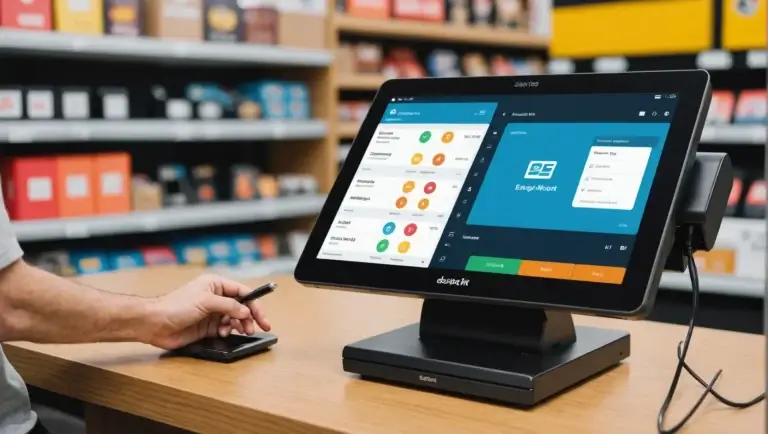Best POS Systems for Small Businesses in 2025 Ultimate Guide

1. Introduction to POS Systems
A Point of Sale (POS) system is the technology that enables businesses to process customer transactions. But in today’s digital landscape, it’s not just about handling payments anymore. POS systems have evolved into full-fledged business management solutions. Especially for small businesses, the right POS system can be a game-changer.
Imagine running a busy coffee shop. Orders are flying in, inventory is depleting fast, and employees are trying to manage everything manually. Sounds like chaos, right? That’s where a POS system steps in. It acts as the central hub of business operations, integrating sales, inventory, and customer management into one seamless interface.
Small businesses face unique challenges—limited manpower, tighter budgets, and a need for agility. A smart POS system doesn’t just handle transactions—it helps optimize processes, reduce errors, save time, and boost overall productivity. Whether you’re in retail, food service, or services like salons and repair shops, having a tailored POS solution is essential.
From tracking product sales to managing staff shifts and generating end-of-day reports, today’s POS systems are built to simplify life for small business owners. They’re intuitive, cloud-powered, and often mobile-friendly, letting you run your business from anywhere.
In this guide, we’ll walk through the types of POS systems, explore must-have features, break down the top-rated options for 2025, and help you make an informed decision. Because the right POS system is more than just a cash register—it’s your business growth partner.
2. Types of POS Systems
Picking the right type of POS system starts with understanding what’s out there. Not all systems are built the same. The one you choose should align with your business model, size, and industry. Let’s break down the major categories.
Cloud-Based vs. On-Premise POS
Cloud-based POS systems store data on remote servers and are accessed via the internet. Think of it like Google Drive for your business transactions. These systems are flexible, easy to update, and allow for real-time syncing across devices. If you’re managing multiple locations or want to keep an eye on your store while you’re away, cloud-based is the way to go.
On the other hand, on-premise POS systems run on local servers. They can offer faster performance in low-connectivity environments, but come with higher upfront costs, complex maintenance, and less mobility.
Mobile POS (mPOS) Systems
These are perfect for small businesses on the go—pop-up shops, food trucks, or market vendors. A mobile POS usually runs on a tablet or smartphone and supports wireless card readers. It’s lightweight, cost-effective, and ideal for businesses with minimal infrastructure.
Self-Service & Kiosk POS
Growing in popularity, these systems allow customers to place their own orders—think of McDonald’s self-ordering kiosks. While more common in larger retail and fast food chains, they’re also a great fit for small businesses with high foot traffic looking to speed up service and reduce labor costs.
Each of these POS types offers unique benefits. Choosing the right one depends on your business needs, location, number of employees, and growth goals.
3. Key Features of a Great POS System
When shopping for a POS system, don’t just look for the basics. A cash register with a card reader doesn’t cut it anymore. You want a solution that does more—much more.
Sales Tracking and Analytics
A top-tier POS system gives you detailed insights into your sales. What are your best-selling items? Which time of day sees the most purchases? Which promotions actually work? With advanced analytics, you can make data-backed decisions instead of relying on guesswork.
Inventory Management
Running out of stock or over-ordering eats into profits. With integrated inventory management, your POS tracks every item sold, alerts you when stock is low, and can even automate reordering. For small retail businesses, this feature is an absolute lifesaver.
Customer Relationship Management (CRM)
Know your customers. With CRM features, your POS system stores customer info, purchase history, and preferences. Use it to launch loyalty programs, send personalized emails, and improve customer retention. In 2025, customer experience is everything—and CRM tools put you ahead of the game.
Employee Management and Permissions
Keep track of staff performance, shifts, and access levels. A great POS system lets you assign roles, set permissions, and even monitor sales by employee. This not only improves accountability but helps you reward top performers and identify training needs.
Whether you’re selling coffee or cutting hair, a POS with these features helps streamline operations and scale your business more effectively.
4. Benefits of Using POS Systems for Small Businesses
Still on the fence about investing in a POS system? Let’s talk benefits—real, measurable improvements that come with the right setup.
Improved Efficiency
Forget manual logs and end-of-day number crunching. With a modern POS, everything from sales to payroll is automated. Transactions are faster, queues are shorter, and your staff can focus on serving—not scrambling.
Better Customer Experience
Speed, personalization, and convenience are what today’s customers expect. A POS system lets you deliver all three. From customized receipts to instant refunds and loyalty rewards, a good POS helps build a memorable shopping experience.
Real-Time Data Access
Need to check today’s sales while on vacation? With cloud-based POS, your data is available in real time, from any device. Make quick decisions, even when you’re off-site.
Accurate Inventory and Sales Reporting
One of the biggest killers of small business profit? Poor inventory management. A POS ensures that you never sell what’s out of stock and you’re never left with unsold items collecting dust.
Plus, with built-in reporting, tax time becomes a breeze. You’ll have all the numbers you need, ready and accurate.
5. Top POS Systems for Small Businesses in 2025
We’ve done the research so you don’t have to. Here are the best POS systems for small businesses in 2025, ranked by features, ease of use, pricing, and support.
Square POS
- Best for: Mobile businesses and startups
- Pros: Free plan available, intuitive UI, excellent for service-based businesses
- Features: Inventory, sales reports, CRM, invoicing
- Pricing: Starts at $0/month + transaction fees
Clover
- Best for: Retail and quick-service restaurants
- Pros: Customizable hardware, flexible software plans
- Features: Employee management, customer loyalty, contactless payments
- Pricing: Hardware from $49; software starts at $14.95/month
Toast POS
- Best for: Restaurants and food trucks
- Pros: Built specifically for food service
- Features: Table management, online ordering, delivery integrations
- Pricing: Starts at $0/month with pay-as-you-go hardware
Lightspeed Retail
- Best for: Inventory-heavy businesses like apparel or electronics
- Pros: Strong inventory tools, ecommerce integration
- Features: Supplier orders, bulk product imports, customer profiles
- Pricing: Starts at $69/month
Shopify POS
- Best for: E-commerce sellers expanding into brick-and-mortar
- Pros: Seamless sync with Shopify online store
- Features: Omnichannel selling, unified inventory, discount codes
- Pricing: Starts at $29/month (with Shopify subscription)
6. How to Choose the Right POS System for Your Small Business
With so many options on the market, choosing the right POS system can feel overwhelming. But don’t worry—we’ve broken down the process into a few simple steps to help guide your decision.
Define Your Business Needs
First, assess what your business truly needs. Are you in retail, food service, or personal services? Do you need inventory tracking, customer profiles, or just a way to process payments? Knowing your priorities will instantly narrow your choices.
Consider Your Budget
How much can you afford upfront? What about monthly fees? Some POS systems like Square offer free starter plans, but others may charge based on features, users, or terminals. Be sure to look at hidden costs—hardware, software upgrades, payment processing fees, and support charges can add up.
Scalability
Think about where your business is heading. You might be a single-store operator now, but what about a year from now? Choose a POS system that grows with you—whether that means adding registers, integrating with e-commerce, or managing multiple locations.
Ease of Use
You don’t want to spend hours training staff or figuring out how to close out the day. Go for a system with a clean, intuitive interface. Bonus points if they offer onboarding support or free training.
Customer Support
Let’s be real—technical issues will pop up. That’s why 24/7 customer support is non-negotiable. Check if support is included, how responsive they are, and what channels they offer (live chat, phone, email).
The right POS system is one that not only fits your current business needs but also aligns with your long-term growth plans.
7. POS Hardware You Might Need
While software gets all the attention, don’t underestimate the importance of the hardware. The tools you use physically can have a huge impact on speed, accuracy, and overall experience.
1. Register or Terminal
This is the central unit—like a computer or tablet—where transactions are entered. Many systems now use iPads or Android tablets for flexibility and style. It’s the “command center” of your POS.
2. Receipt Printer
Even in a digital world, paper receipts are still important for many businesses. Thermal printers are fast, quiet, and reliable. Make sure your POS system is compatible with whatever printer you choose.
3. Barcode Scanner
For retail businesses, a barcode scanner can drastically speed up checkout times and reduce manual errors. It’s especially helpful for inventory management and product tracking.
4. Cash Drawer
Yes, cash is still a thing—especially for certain demographics or small towns. An integrated cash drawer keeps things secure and organized, automatically popping open for cash sales.
5. Card Reader or Payment Terminal
This is critical. Your reader should support EMV chip cards, NFC (contactless payments) like Apple Pay or Google Pay, and traditional swipes. Security and compatibility are key here.
Make sure to confirm that your POS software supports all the hardware you plan to use—ideally with plug-and-play functionality to reduce setup stress.
8. Integrations That Maximize Your POS Power
Your POS system doesn’t work in a vacuum. The best ones integrate seamlessly with other tools, helping you automate tasks and build an efficient ecosystem.
Accounting Software
Linking your POS with accounting software like QuickBooks or Xero helps automate financial tracking, saving time and reducing human error. Sales data flows directly into your books.
E-commerce Platforms
If you sell online through Shopify, WooCommerce, or BigCommerce, your POS system should sync inventory, sales, and customer data between online and offline channels.
Marketing Tools
Email platforms like Mailchimp or SMS marketing tools can pull customer data from your POS to create targeted campaigns and loyalty programs.
Employee Scheduling Tools
Integrate apps like Deputy or Homebase to manage shifts, time tracking, and payroll from one place—directly connected to your sales performance.
The more integrations you can make, the smoother your operations become. You’ll reduce duplicate work, improve accuracy, and have more time to focus on growth.

9. Common Mistakes Small Businesses Make with POS Systems
Even with the best intentions, small businesses can fall into some common traps when choosing or using a POS system. Let’s help you avoid them.
1. Choosing Based on Price Alone
Yes, budget matters. But going with the cheapest option often means sacrificing features, reliability, or support. Look for value, not just price.
2. Ignoring Scalability
A POS that works for a single pop-up shop may fall short when you open a second location. Choose a system with features you might need down the line—like multi-store support or robust reporting.
3. Not Training Staff Properly
Even the best system is useless if your team doesn’t know how to use it. Invest time in onboarding and training, and create quick-reference guides for daily operations.
4. Failing to Regularly Update Software
Outdated software can lead to security vulnerabilities, glitches, or lack of new features. Keep your POS up to date to benefit from the latest improvements and security patches.
5. Skipping the Trial Period
Most providers offer a free trial or demo. Use it! Test how it fits into your daily operations, and get feedback from your staff before committing long term.
Avoid these mistakes, and you’ll save yourself time, money, and a whole lot of frustration.
10. Cost Breakdown: What to Expect When Buying a POS System
So, what’s the real cost of getting a POS system? Let’s break it down so you’re not caught off guard.
| Component | Low-End Estimate | High-End Estimate |
|---|---|---|
| POS Software (monthly) | $0 – $99 | $200+ |
| Hardware Bundle | $300 – $800 | $1,500+ |
| Payment Processing Fees | 2.5% – 3.5% per transaction | Depends on provider |
| Add-ons/Integrations | $0 – $50/month | $100+/month |
| Installation/Setup | Free – $200 | $500+ (for in-person setup) |
Some POS companies offer bundled pricing, while others let you choose à la carte. Be sure to compare total cost of ownership, not just the initial sticker price.
Also, consider the ROI. A well-implemented POS system can pay for itself through increased efficiency, better inventory management, and higher sales.
11. Security Features to Look For in a POS System
When handling customer data and processing payments, security isn’t optional—it’s a necessity. A POS system must offer robust security features to protect both your business and your customers from fraud and cyber threats.
End-to-End Encryption
This ensures that data is encrypted from the moment a card is swiped or tapped until it reaches the payment processor. Even if someone intercepts the information mid-transit, they won’t be able to use it.
PCI Compliance
The Payment Card Industry Data Security Standard (PCI DSS) is a mandatory set of guidelines that any business handling card payments must follow. Your POS provider should be fully PCI compliant, and they should help guide you on how to remain compliant as well.
User Permissions and Role-Based Access
Not everyone in your team needs access to every part of the system. A secure POS system allows you to assign roles and set restrictions, so employees can only access the data relevant to their job. This limits internal data breaches and misuse.
Cloud Backups and Disaster Recovery
Systems crash. Devices get lost. Without a secure cloud-based backup, you could lose critical business data. A POS system with automatic backups ensures your data stays safe and can be recovered quickly in case of a hardware failure.
Fraud Detection and Alerts
Some advanced POS systems offer tools that detect suspicious activity—like unusually large refunds or after-hours logins. Being alerted in real-time gives you a chance to stop fraud before it escalates.
In short, don’t cut corners on security. It’s better to be proactive now than reactive later, especially when sensitive customer data is involved.
12. Mobile POS Solutions: The Future of Small Business Sales
Mobile POS (mPOS) systems are changing the game for small businesses. Whether you’re operating a food truck, pop-up store, farmer’s market stall, or salon, mPOS brings the power of a full cash register to your smartphone or tablet.
Portability Equals Flexibility
With a mPOS, you’re not chained to a counter. You can ring up sales at a sidewalk booth, during a home visit, or even at events and conventions. For small businesses looking to maximize mobility, this is a huge win.
Lower Costs
Compared to traditional setups, mPOS systems require minimal hardware—often just a phone or tablet and a small card reader. This significantly reduces upfront costs, making it ideal for startups or solo entrepreneurs.
Enhanced Customer Experience
Imagine this: your customer doesn’t have to wait in line—they can check out wherever they are. That convenience boosts satisfaction and can lead to more sales. Some mPOS apps even support digital receipts, tipping, and loyalty points.
Popular mPOS Options
- Square – Arguably the most popular mPOS for small businesses. Offers hardware starting under $50 and a user-friendly interface.
- Shopify POS – Great for merchants already selling online.
- SumUp – Known for affordable pricing and simple functionality.
Mobile POS is more than just a trend—it’s the future of retail and service for agile small business owners.
13. Cloud-Based POS vs. Traditional POS: Which Is Better?
The debate between cloud-based and traditional (on-premise) POS systems is ongoing, but for small businesses in 2025, the scale is tipping heavily toward the cloud.
Accessibility
Cloud-based POS systems let you access your sales, inventory, and customer data from anywhere—whether you’re on vacation, at home, or managing multiple stores remotely. Traditional POS systems usually require you to be on-site.
Cost Efficiency
With cloud-based systems, there’s no need for expensive servers or maintenance contracts. You pay a manageable monthly fee and updates are automatic. Traditional systems often come with high upfront costs and need manual updates.
Real-Time Data Syncing
A cloud-based system syncs everything in real time. That means if you sell an item in-store, your online inventory is updated instantly. Traditional systems often experience lags, or require syncing at the end of the day.
Security and Updates
Most cloud POS providers offer bank-level security, frequent backups, and software updates at no extra cost. With on-premise systems, you’re responsible for managing and securing everything yourself—a costly and time-consuming task.
When Traditional POS Makes Sense
In rare cases—like businesses with poor internet connectivity or needing extreme customization—an on-premise solution may be preferable. But for 90% of small businesses today, cloud-based is the smarter, more flexible choice.
14. Industry-Specific POS Solutions for Small Businesses
Different industries have different needs. A clothing store doesn’t require the same POS features as a bakery or hair salon. Fortunately, POS technology has evolved to provide industry-specific solutions.
Retail
Retail POS systems focus heavily on inventory management, barcode scanning, and CRM. Key players like Lightspeed and Shopify POS offer detailed analytics, supplier integration, and bulk import tools.
Restaurants and Cafés
These systems include features like table management, split bills, online ordering, and kitchen display systems (KDS). Toast POS and Square for Restaurants are strong choices here.
Salons and Spas
Time-slot booking, service tracking, stylist performance, and tip management are vital. Systems like Fresha and Vagaro cater specifically to this sector.
Service-Based Businesses
Freelancers, consultants, and repair services benefit from invoicing, mobile payments, and customer notes. Square Appointments and QuickBooks POS are ideal.
Choosing a POS built for your niche ensures smoother operations, happier customers, and features that actually support how your business runs.
15. Final Tips for Successfully Implementing a POS System
Switching to a new POS system isn’t just a tech upgrade—it’s a transformation of your daily operations. Follow these tips to ensure a smooth rollout.
Plan the Transition
Don’t switch systems during your busiest time of year. Choose a slower period to train staff, migrate data, and troubleshoot.
Back Up Everything
Before going live, back up your old data—inventory lists, sales reports, and customer databases. You’ll thank yourself if anything goes wrong during setup.
Train Your Staff
Even the most intuitive system needs some learning curve. Conduct hands-on training and use cheat sheets for common tasks like issuing refunds or checking reports.
Test Run Before Full Launch
Use the new system in parallel with your old one (if possible) for a few days. This dry run helps you identify any issues and get comfortable before fully switching.
Ask for Support
Use your provider’s resources—help centers, chat support, video tutorials—to get the most out of your new system. Most providers offer free setup calls or onboarding assistance.
A smooth POS implementation means fewer disruptions, more sales, and faster ROI.
Conclusion
Choosing the right POS system for your small business in 2025 isn’t just about processing payments—it’s about transforming the way you run and grow your business. Whether you need cloud-based flexibility, mobile functionality, or industry-specific tools, there’s a solution out there designed just for you.
Remember, your POS system is the backbone of your operation. It touches every part of your business, from sales to customer experience. Take the time to choose wisely, invest in training, and make the most of your tech.
When done right, a POS system doesn’t just support your business—it supercharges it.




